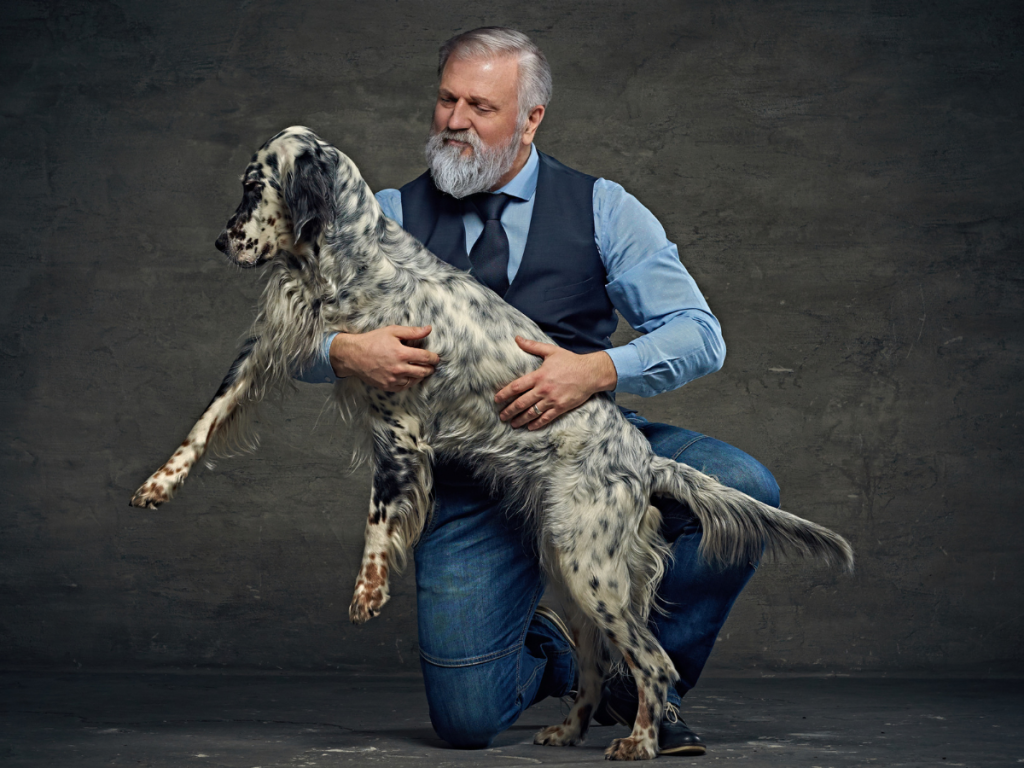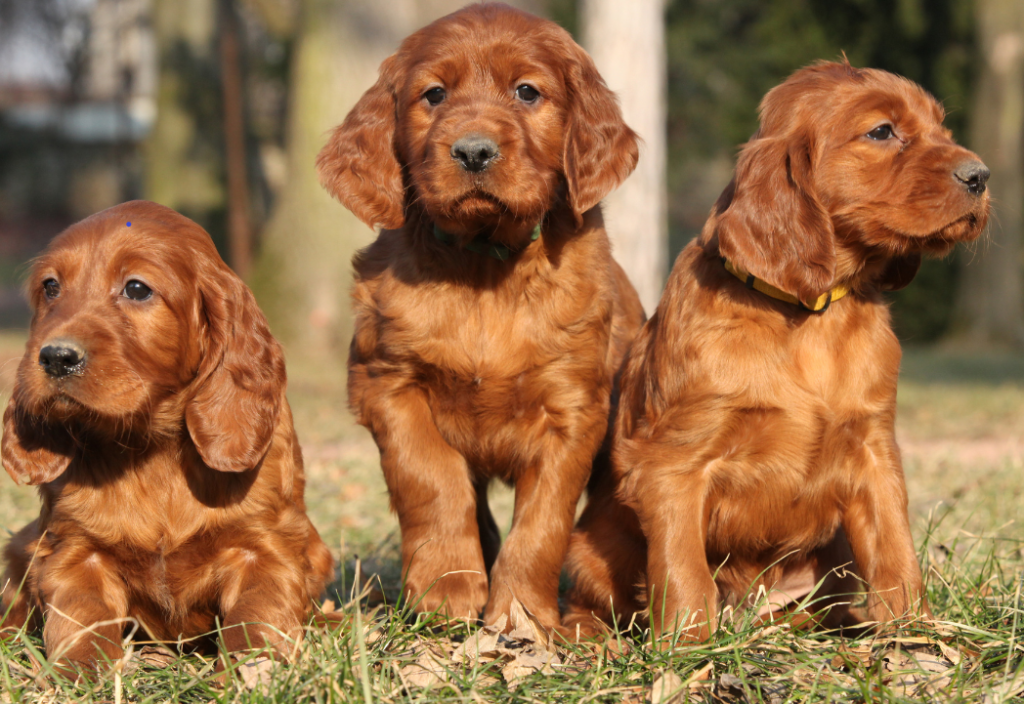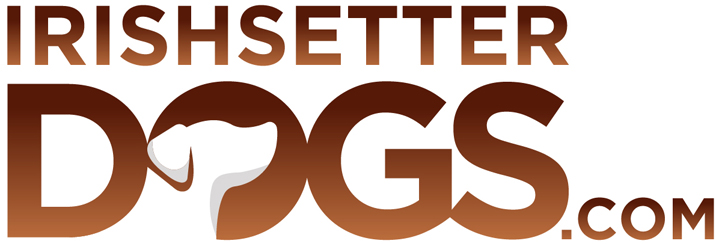Have you ever wondered what goes into producing a purebred dog? Well, let’s take a deeper look into the world of Irish Setter breeding and reproduction. The breeding process can be complex and extensive to ensure the resulting puppies’ health and quality. It involves carefully selecting the right mate, ensuring they have proper health clearances and the same genetic diseases to minimize any potential health problems.
The beauty and grace of the Irish Setter are not just coincidence but rather the result of careful planning and execution in the breeding process. So let’s learn more about the process of Irish setter breeding and reproduction.
The Evolution of Breeding Practices in Irish Setters
Breeding practices play a crucial role in shaping dog breeds’ characteristics and overall health. Over the years, the breeding practices for Irish Setters have undergone significant changes, driven by advancements in genetic knowledge and a growing emphasis on responsible breeding.
In the early days of Irish Setter breeding, the focus was on enhancing specific traits such as coat color and hunting abilities. Breeders relied on selective mate pairing, often based on physical appearance alone. However, as our understanding of genetics grew, so did the need for more informed and responsible breeding practices.
Currently, the advancements in genetic testing have been invaluable in improving breeding practices for Irish settlers. By identifying potential genetic disorders or predispositions, breeders can make informed decisions when selecting mates, reducing the risk of passing on hereditary health issues to future generations. Genetic tests for conditions like hip dysplasia, progressive retinal atrophy, and von Willebrand’s disease have helped breeders prioritize the health and well-being of the breed.
The Role of Breed Standards in Guiding Responsible Breeding Practices
Breed standards serve as a compass for responsible dog breeders, providing guidelines and benchmarks to ensure the preservation and improvement of specific breeds. These standards outline a breed’s desired physical characteristics, temperament, and overall health. Below are the crucial roles that breed standards play in guiding responsible breeding practices, promoting dogs’ well-being, and preserving breeds’ integrity.
➩Setting the Blueprint for Excellence
Breed standards act as a blueprint for breeders, outlining the ideal traits and characteristics that define a particular breed. These standards provide clarity and consistency, ensuring breeders understand what they should strive for in their breeding programs. By adhering to these standards, breeders can work towards producing dogs that embody the breed’s unique qualities.
➩Promoting Health and Functionality
One of the primary objectives of breed standards is to prioritize a breed’s overall health and functionality. Standards often emphasize structural soundness, promoting optimal physical function and reducing the risk of hereditary health issues. For example, breed standards may specify the correct angulation of joints, the proportionate size of various body parts, or the absence of certain genetic disorders. By focusing on these health-related aspects, breeders can help ensure the long-term well-being of their dogs.
➩Encouraging Responsible Selection of Mates
Breed standards play a vital role in guiding responsible mate selection. Breeders refer to breed standards to identify suitable mates that complement and enhance desirable traits while minimizing the risk of passing on hereditary health issues. By aligning their breeding choices with the breed standards, breeders promote the production of offspring that adhere to the desired breed characteristics, temperament, and health.
➩Preserving Breed Integrity
Breed standards are instrumental in preserving the integrity and distinctiveness of individual breeds. By defining the unique traits and characteristics that define a breed, standards help ensure that breeders maintain and propagate these distinguishing features. This focus on breed integrity allows for the continued appreciation and recognition of specific breeds, enriching the diversity and heritage of the dog world.
➩Continuous Improvement and Adaptation
Breed standards are not static documents; they evolve over time to reflect changing perspectives, scientific advancements, and societal expectations. As knowledge about health issues and genetic diversity expands, breed standards may be revised to address emerging concerns. Breeders who embrace these updates and adapt their breeding practices accordingly contribute to the ongoing improvement and welfare of the breed.
Breed standards play a vital role in guiding responsible breeding practices. Embracing these standards is essential for fostering responsible breeding practices and ensuring the long-term future of our beloved canine companions.
Reproductive Anatomy and Physiology

To fully understand the reproductive processes in Irish Setters, it is important to have a basic understanding of their male and female reproductive systems. The male reproductive system consists of testes, which produce sperm, and accessory glands that contribute fluids to support the sperm’s journey. On the other hand, the female reproductive system includes ovaries, which release eggs, and a uterus, where fertilization and pregnancy occur.
In male Irish Setters, the testes are the primary reproductive organs responsible for producing sperm. These oval-shaped organs are located within the scrotum, outside the body cavity, to maintain an optimal temperature for sperm production. Additionally, the penis, which aids in mating and the delivery of sperm, is another vital organ in the male reproductive system.
In female Irish Setters, the ovaries are the key reproductive organs. They are responsible for producing eggs, or ova, which are released during the estrous cycle. The ova travel through the fallopian tubes, where they may be fertilized by sperm. The uterus, or womb, provides a nurturing environment for the development of embryos during pregnancy.
∎The Estrous Cycle in Female Irish Setters
Female Irish Setters go through an estrous cycle or heat. This cycle has numerous phases. Proestrus begins the cycle when the female draws attention from males but is not ready to mate. Estrus follows proestrus when the female appears most fertile and breeding-ready. Metestrus and diestrus follow estrus, causing hormonal changes and pregnancy. Without mating, the cycle concludes with anestrus, which allows for recuperation before the next cycle.
∎Hormonal Influences on Reproduction
Hormones play a significant role in regulating the reproductive processes in Irish Setters. In males, testosterone is the primary hormone responsible for sperm production and sexual behavior. It influences the development of secondary sexual characteristics and drives mating behaviors. In females, estrogen and progesterone control the estrous cycle and prepare the reproductive system for pregnancy. These hormonal fluctuations are essential for successful reproduction and maintaining overall reproductive health in Irish Setters.
Pre-Breeding Considerations for Responsible Irish Setter Breeding and Reproduction

Before embarking on breeding Irish Setters, it is essential to consider several factors that will contribute to the breeding program’s health, temperament, and overall success. Below is the health screening process for potential breeding pairs.
✔️Genetic Testing
As mentioned, Genetic testing is vital in determining the potential health risks associated with breeding Irish Setters. It helps identify any genetic disorders or hereditary conditions that may be present in the breeding pair. Tests can include screening for conditions like hip dysplasia, progressive retinal atrophy, and autoimmune diseases. Breeders can make informed decisions by conducting genetic testing and avoid passing on these health issues to future generations.
✔️Common Health Issues in Irish Setters
Familiarizing oneself with the common health issues prevalent in Irish Setters is crucial. Conditions such as hypothyroidism, epilepsy, and allergies can be seen in this breed. By understanding these health concerns, breeders can develop strategies to minimize the risk of these conditions through careful selection of breeding pairs and proper veterinary care.
✔️Evaluating Temperament and Behavior
Ensuring that Irish Setters have desirable physical traits and sound temperament and behavior is paramount. Breeders should assess the temperament of potential breeding dogs, looking for traits such as friendliness, trainability, and stability. Dogs with aggressive or fearful tendencies should not be used for breeding, as these traits can be passed down to offspring. By focusing on temperament, breeders contribute to Irish Setters’ overall well-being and long-term suitability as family pets.
✔️Age Considerations for Breeding Irish Setters
The age at which Irish Setters are bred is a critical factor to consider. It is generally recommended to wait until dogs have reached maturity, both physically and mentally, before initiating the breeding process. Female Irish Setters should ideally be at least 2 years old, allowing their bodies to develop fully and reducing the risk of complications during pregnancy and whelping. Male Irish Setters can start breeding around the age of 1 year, but it is essential to ensure they are emotionally and physically ready for the responsibilities of fatherhood.
✔️Creating a Breeding Plan and Goals
A well-defined breeding plan and goals are essential for responsible breeding practices. Breeders should establish the purpose of their breeding program, whether it is to improve specific traits, maintain breed standards, or contribute to the breed’s overall health. A breeding plan should include careful selection of breeding pairs based on health, temperament, and physical attributes. It is important to consider the genetic diversity and potential matches that complement each other’s strengths and weaknesses.
Irish Setter Breeding and Reproduction
Now that we have discussed the importance of health and temperament in Irish Setters, let’s delve into the actual breeding and reproduction process.
🔵Recognizing Signs of Estrus:
Timing is everything when it comes to successful breeding. It starts with recognizing the signs of estrus, also known as heat, in the female dog. These signs include a swollen vulva, increased urination, and a behavior change. Keeping a close eye on these physical and behavioral cues will help determine when the female is ready for mating.
🔵Determining the Optimal Mating Time:
Once estrus has been identified, it is crucial to determine the optimal mating time. It is usually when the female is most receptive to mating and has reached the peak of her fertility. Breeders often use techniques such as vaginal cytology or progesterone testing to pinpoint this precise window of opportunity. By timing the mating correctly, breeders increase the likelihood of successful fertilization and pregnancy.
🔵Natural Breeding vs. Artificial Insemination
When it comes to breeding, there are two primary methods: natural breeding and artificial insemination. Each method has its own advantages and considerations.
- Natural breeding occurs when the male and female dogs mate naturally, allowing for direct transfer of semen. This method allows for natural selection and ensures that only healthy and fertile dogs reproduce. However, it requires careful supervision to ensure successful mating and may not always be feasible due to geographical distances or temperamental differences between the dogs.
- Artificial insemination, on the other hand, involves collecting semen from the male and depositing it into the female’s reproductive tract. This method allows breeders to overcome distance or incompatible temperaments between the dogs. It also enables the use of frozen or chilled semen, expanding the pool of potential mates. However, it requires technical expertise and specialized equipment.
🔵Selecting Appropriate Mates to Enhance Breed Qualities
Selecting appropriate mates is a crucial aspect of responsible breeding. Breeders aim to enhance desirable breed qualities and minimize the risk of passing on genetic health issues. Careful consideration is given to factors such as temperament, conformation, health history, and genetic compatibility. By selecting mates that complement each other’s strengths and weaknesses, breeders can improve the overall quality and characteristics of the breed.
🔵The Role of the Breeder During the Mating Process
The breeder plays a pivotal role during the mating process. They are responsible for ensuring the comfort and safety of both the male and female dogs. This includes providing a suitable environment for mating, supervising the process to ensure successful copulation, and addressing any unforeseen complications. Additionally, the breeder may provide support and guidance to new owners during the gestation period and whelping process, helping ensure the well-being of the dam and the puppies.
Post-Breeding Care

Bringing new life into the world is an exciting time, but it also requires responsible and attentive care. After breeding an Irish Setter, it is crucial to provide proper post-breeding care to ensure the health and well-being of the mother and puppies. The pregnant Irish Setter requires extra care and attention during the pregnancy period. Here are some important considerations:
- Nutritious diet: Providing a balanced and nutritious diet is essential for the health of the pregnant Irish Setter and the developing puppies. Consult with a veterinarian to establish an appropriate diet plan that meets the mother’s specific needs during this crucial time.
- Exercise and rest: Moderate exercise benefits the pregnant Irish Setter, but avoid excessive physical exertion or strenuous activities that may put unnecessary stress on her body. Additionally, providing a calm and comfortable environment where the mother can rest and relax is vital for her well-being.
- Regular veterinary check-ups: Schedule regular veterinary check-ups throughout the pregnancy to monitor the health of the mother and the developing puppies. These check-ups can help identify any potential issues early on and ensure proper care and interventions if needed.
Post-birth Care for the Mother and Puppies
After the birth of the puppies, the care and well-being of both the mother and the newborns become a top priority. Here are some important aspects of post-birth care:
- Clean and safe whelping area: Create a clean and safe whelping area for the mother and puppies. Ensure the area is warm, free from drafts, and away from potential hazards. Regularly clean and sanitize the area to maintain a hygienic environment.
- Nursing and feeding: The mother will naturally nurse the puppies, giving them essential nutrients through her milk. Ensure the mother has access to fresh water and a high-quality diet to support her milk production and overall health.
- Monitoring and socialization: Monitor the mother and puppies closely to ensure they are healthy and thriving. Observe their behavior, weight gain, and overall development. Gradually introduce gentle handling and socialization to familiarize the puppies with human touch and different environments.
Take note: regular veterinary check-ups are crucial during the post-breeding period. Veterinary professionals can provide valuable guidance and support in monitoring the health and growth of the mother and the puppies. These check-ups allow for early detection and intervention in case of any health issues, ensuring that appropriate measures are taken promptly.
Veterinarians may also provide important vaccinations and deworming treatments for the puppies to protect them from potential diseases and parasites. Moreover, they can offer advice on nutrition, behavior, and general care tailored to the specific needs of the mother and puppies.
Frequently Asked Questions
How many puppies can I expect from an Irish Setter litter?
The average Irish Setter litter size ranges from 6 to 8 puppies. However, it’s important to note that litter sizes can vary. Some litters may have fewer puppies, while others might have more. Each dog is unique, and factors such as the dam’s age, health, and genetics can influence litter size.
What are the common signs that an Irish Setter is pregnant?
When an Irish Setter is pregnant, you may notice several signs. These can include a change in appetite, weight gain, nipple enlargement, and behavioral changes. It’s always recommended to consult a veterinarian to confirm pregnancy and receive guidance on proper prenatal care.
Should I let my Irish Setter have a natural birth or opt for a C-section?
The delivery method depends on various factors and should be discussed with a veterinarian. In general, Irish Setters can give birth naturally, but certain circumstances may require a C-section. These include difficulties during labor or if the dam has had previous complications. Your veterinarian will assess the situation and provide guidance based on the specific needs of your Irish Setter.
What should I feed my pregnant Irish Setter to support her and the puppies?
Proper nutrition is crucial during pregnancy. Transitioning to a high-quality, specialized diet formulated for pregnant and nursing dogs is recommended. This diet should provide essential nutrients for the dam and the developing puppies. Consult your veterinarian for specific dietary recommendations and feeding guidelines tailored to your Irish Setter’s needs.
Is it necessary to have the male Irish Setter tested for fertility before breeding?
Yes, it is advisable to have the male Irish Setter tested for fertility before breeding. Ensuring the male’s fertility helps increase the chances of successful mating and pregnancy. A veterinarian can conduct tests to assess the male’s reproductive health, including semen analysis and fertility evaluations.
Can I breed my Irish Setter with a different breed of dog?
Breeding an Irish Setter with a different breed is known as crossbreeding or mixed breeding. It’s essential to consider the potential implications of crossbreeding, including variations in temperament, appearance, and health risks. Responsible breeders generally focus on preserving the integrity of the Irish Setter breed by breeding within the same breed. If you are considering crossbreeding, it’s crucial to research and consult with professionals to understand the potential outcomes and responsibilities associated with this decision.
Final Words
In conclusion, the world of Irish setter breeding and reproduction is a complex and emotional journey. As someone who has researched this topic extensively, it is clear that the breeders who dedicate their lives to properly breeding these beautiful dogs are akin to artists, using their knowledge and skills to create the perfect balance of health, temperament, and physical characteristics. While certainly challenges and risks are associated with breeding, the rewards are immeasurable.
Seeing the joy on the faces of families who welcome a new Irish setter into their home, knowing that they are providing a loving and safe environment for a dog that has been carefully bred and raised, is heartwarming. It is important that we continue to support responsible breeding practices and educate the public on the importance of proper reproductive care for our canine companions. Through these efforts, we will ensure that future generations of Irish setters are healthy, happy, and cherished members of our families.
